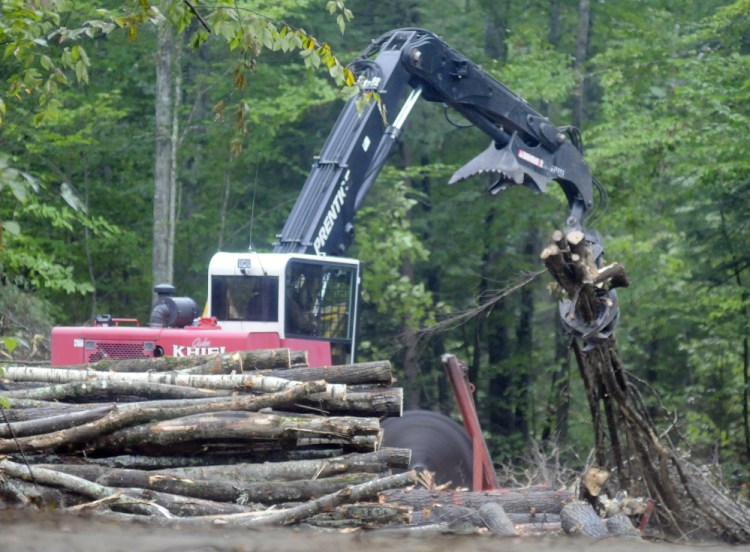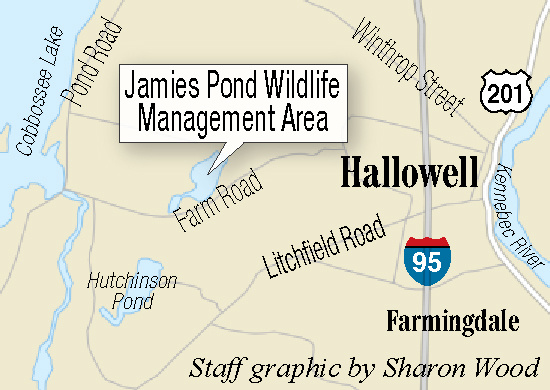HALLOWELL — A controversial timber harvesting project at a popular central Maine wildlife area is likely ahead of schedule with more work planned for this summer.
The project at the approximately 1,000-acre Jamies Pond Wildlife Management Area in Hallowell, Manchester and Farmingdale began in August and is roughly 75 percent complete, said an official with the Department of Inland Fisheries & Wildlife, which oversees the project, during a Hallowell Conservation Commission meeting. It’s the first timber harvesting project at Jamies Pond in more than a decade.
“We’ve had really good operating conditions, and we haven’t had significant challenges because we had a very dry fall,” said G. Keel Kemper, a regional wildlife biologist for the agency. “We feel pretty good about it.”
The timber harvesting effort includes the removal of certain trees to allow other, younger trees to flourish, thus increasing foraging opportunities for deer, snowshoe hare and turkey. In addition, work is designed to improve a deer wintering area to increase openings in aspen-dominated areas to provide habitat for grouse and woodcock. The agency also built roads for vehicles and equipment that are temporary for use but essentially permanent by footprint.
Eric Hoar, a lands management biologist and the timber harvest’s project manager, said they’ve operated on 450 acres so far and have removed more than 4,800 gross cords of wood.
“We’ve been pleased with the habitat enhancements we’ve been able to make thus far,” Hoar told the commission. “It’s been a good operation.”
Hoar said the operation will continue north of the pond and around many of the most popular trails this summer.
The plan’s announcement in June was met with criticism and questions from people afraid that their hiking and walking trails would be disturbed and forever changed. The wildlife agency hosted a site walk and held a lively public meeting to try to alleviate concerns, and Hoar said the process has gone smoothly.
“We’ve been proactive describing our management and our goals and how the landscape and wildlife may change,” he said. “We’ve had a lot of interaction with the public on the ground and have had the opportunity to meet a lot of people. There’s been people showing up asking what was going on.”
Last year, several people questioned the management agency’s decision to work on 70 percent of the property while removing trees and disturbing trails and other recreation areas. Scott Schiff-Slater, a family doctor in Hallowell, wrote several emails and met with officials and Wildlife Commissioner Chandler Woodcock to share his objections to the project. He said he didn’t attend this month’s meeting in Hallowell because the meetings are just agency officials telling their plan, “not really openly listening and reacting to citizen feedback.”
Schiff-Slater said he thought too many trees were being cut and that the entire project was “stunningly wrong, shortsighted and misguided.” He said it may be a stretch, but he thinks the project at Jamies Pond represents the shortsighted thinking that is leading to global warming.
“What they have done at Jamies Pond is really a shame and a disgrace,” Schiff-Slater said Monday in an email. “The department has taken a unique, beautiful natural area that was a real treasure for people and the environment and the wildlife and the economy of central Maine and turned it into a pretty and pleasant vanilla wood lot.”
Kemper and Hoar have said the agency always tries to consider people’s recreational use when planning a timber harvesting project like this one, but they stressed that wildlife habitat management was their No. 1 objective.
“These lands were acquired to be managed for wildlife and that is our primary objective,” Kemper said. “‘Management’ is an active word, and we’re not in the trail management business.”
The agency has made more than two-thirds of what it has invested by selling the harvested timber, Hoar said. The wood market has “dropped like a stone,” he said, and they’ve made close to $142,000 so far.
Ryan Robicheau, wildlife management section supervisor, said many people described the project as just extensive tree cutting and removal, but it is consistent with any other wildlife areas the department manages throughout the state. The agency oversees 62 wildlife management areas in Maine, representing about 105,000 acres.
“(The work) is very much geared toward wildlife and wildlife habitat first and foremost,” Robicheau said. “(Jamies Pond’s) look will change after we’re done, but we never intended to impact people’s use or enjoyment of the property.”
Jason Pafundi — 621-5663
Twitter: @jasonpafundiKJ
Send questions/comments to the editors.





Comments are no longer available on this story